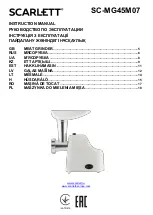
21
6 Activation
WARNING
Risk of injury, if the tools are used
with wrong supply power.
Check that the information on the manufac-
turing label complies with the actual power
supply voltage.
Check that the plug type is the same as the
socket type.
Tools designed for 230 V may be connected
to 220 V / 240 V power supply.
6.1 Switching on and off
Press the safety button [1-4] forwards to
unlock the switch lever [1-3].
Actuate the switch lever [1-3] at the same
time, which then starts up the machine. Re-
lease the lever again to bring the machine
to a standstill.
Continuous operation
Press the safety button [1-4] forwards to
unlock the switch lever [1-3].
Actuate the switch lever [1-3] at the same
time to push the safety button [1-4] for-
wards as far as the stop.
Continuous operation is interrupted by ac-
tuating the switching lever [1-3] again and
releasing it.
6.2 Motor electronics
Starting current limitation
The electronically controlled smooth start-
up ensures that the grinder starts up jolt-
free. Thanks to starting current limitation
of the grinder, 10 A fusing is suf
fi
cient.
Electronic speed selection
The selection thumbwheel [1-7] is used to
set the desired speeds – even during ma-
chine operation:
Level 1: 1000 rpm
Level 4: 1700 rpm
Level 2: 1300 rpm
Level 5: 2000 rpm
Level 3: 1500 rpm
Level 6: 2200 rpm
The required speeds depend on the mate-
rial to be ground. We recommend that you
check this by means of a practical test (see
Application table).
With a high machine load, set the thumb-
wheel [1-7] to the edge position (Level 6).
After a long period of work at low speeds,
allow the grinder to tick over for a further
3 minutes at maximum speed so that the
motor can cool down.
Constant Electronics
The selected motor speeds are maintained
at a constant level by the electronics. This
guarantees a constant working feed and
uniform material removal.
Electronic overload protection
In the event of extreme machine overload-
ing, the motor is protected by the elec-
tronics against damage. For re-starting, the
device must be
fi
rst switched off and again
switched on.
Thermal overload protection
To protect against overheating under ex-
treme, continuous loads, the motor is
switched over to cooling mode by the safety
electronics when a critical temperature is
reached. The grinder cannot be loaded; it
runs a reduced speeds. After a cooling time
of approx. 3 – 5 minutes, the machine can
be operated again at full load. With grinders
at service temperature, the thermal protec-
tion reacts earlier accordingly.
7 Usage
7.1 Selection of the tool head
Different cutter and grinding heads are
available to match the usage and area of
application. A suitable cutter head must be
used to achieve optimum work results –
see table on page 25. The speed selection
data contained in the application table are
recommended values and should be tested
through practical tests.
7.2 Tool head change
WARNING
Before changing the tool, always pull
the mains plug out of the socket.
CAUTION
Always wear protective gloves when
working with the tool head.
►
The maximum permissible speeds of the
tool used must at least match the maxi-
mum speeds of the machine.
Summary of Contents for RGP 150-16 E
Page 2: ...2...
Page 3: ...3...
Page 4: ...4...
Page 123: ...123 5 2 a...
Page 124: ...124 5 3 a...
Page 125: ...125 5 4 a 5 5 a...
Page 128: ...128 3 5 7 7 1 132 7 2 PROTOOL 7 3 2 1 2 2 2 3 2 4 2 6 1 9 2 3 2 2 7 4 1 9 3 1...
Page 130: ...130 7 7 PROTOOL 1 1 35 7 8 1 10 7 9 BG RGP 150 8 9 5 5 1 6...
Page 164: ......
Page 165: ......
















































